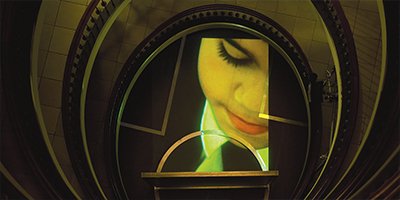
ALGEBRA OF PLACE
A Film Arabesque
2006
A performance that investigates the Arabic Culture
Algebra of Place is an art installation, a film, a performance, seen from above. An architecture with optical illusions. A filmic narrative that, like a arabesque, winds its way through many fictive spaces. Spaces that open up with reception and gifts, show factual knowledge, give stories, and topical events. Spaces that tell about pomp and prejudice, personal care and gender-separated rituals, ancient knowledge, geometry and learning processes.
The woman is the recurring character – in a supporting role. She turns up at the edge of the picture, in the film or in the space as the person who fits herself in or as the one creating the narrative. In this way, the story acquires several points of view – true to the Arabian narrative tradition.
The spectators stand on balconies on seven floors, looking down into a well of images. The woman and the varying film projections challenge the eye and traditional angles from which things are viewed.
The woman is lying on the coach in the lounge before she disappears down the staircase to open the door to the secret space. In a corner, a boy sits playing. The scene in the conference room closes the tour with The Late Night Show. Finally, we talk on the phone with each other, with the world.
Voices, factual sounds and music from the Middle East fill the space as a co-playing sound image, composed on site by the female DJ.
Algebra of Place is an exchange of the thoughts, visions and experiences we have, we have imposed on us, at present, when it is more necessary than ever to distinguish between motive and cause, cause and effect, between names for races, religions and people, between politics, business, art and culture. Art’s comment on the world situation.
Algebra of Place deals with the formation of meanings, with how we construct meaning and significance, with how we break down and build up what is present, that which exists everywhere. The things are seen from many angles. It is movement as form. The sequence in itself is movement, with corridors, blind alleys, rooms and salons, departures and arrivals. An ornamented narrative that engages sight and senses, stimulates thought and reflection.















